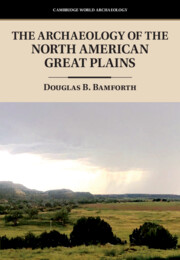Book contents
- The Archaeology of the North American Great Plains
- Cambridge World Archaeology
- The Archaeology of the North American Great Plains
- Copyright page
- Dedication
- Contents
- Figures
- Tables
- Acknowledgments
- Chapter 1 Introduction
- Chapter 2 Where and What Are the Great Plains?
- Chapter 3 Peopling the Continent, Peopling the Plains:
- Chapter 4 Paleoindian Hunters (and Gatherers):
- Chapter 5 Diversity, Environmental Change, and External Connection:
- Chapter 6 Mounds, Pots, Pipes, and Bison:
- Chapter 7 The Context of Maize Farming on the Great Plains
- Chapter 8 Settled Farmers and Their Neighbors, Part 1:
- Chapter 9 Settled Farmers and Their Neighbors Continued:
- Chapter 10 The Plains Village Period, Part 3:
- Chapter 11 One Promise Kept:
- Chapter 12 Afterword
- References
- Index
Chapter 9 - Settled Farmers and Their Neighbors Continued:
The Plains Village Period Part 2, AD 1250 to AD 1400
Published online by Cambridge University Press: 19 November 2021
- The Archaeology of the North American Great Plains
- Cambridge World Archaeology
- The Archaeology of the North American Great Plains
- Copyright page
- Dedication
- Contents
- Figures
- Tables
- Acknowledgments
- Chapter 1 Introduction
- Chapter 2 Where and What Are the Great Plains?
- Chapter 3 Peopling the Continent, Peopling the Plains:
- Chapter 4 Paleoindian Hunters (and Gatherers):
- Chapter 5 Diversity, Environmental Change, and External Connection:
- Chapter 6 Mounds, Pots, Pipes, and Bison:
- Chapter 7 The Context of Maize Farming on the Great Plains
- Chapter 8 Settled Farmers and Their Neighbors, Part 1:
- Chapter 9 Settled Farmers and Their Neighbors Continued:
- Chapter 10 The Plains Village Period, Part 3:
- Chapter 11 One Promise Kept:
- Chapter 12 Afterword
- References
- Index
Summary
By the mid-1200s, a traveler across the Plains would have encountered a wide array of communities and lifeways. In the far southwest, scattered households of small-scale farmers with strong ties to the southern part of the American Southwest lived in much of the Pecos Valley, while similar communities with closer connections to the Taos area lived to the north of them, perhaps into Colorado. People who made brownware pottery like that in the southern Southwest also occupied the grasslands from the Pecos across the southern Llano Estacado and may still have had settlements in the eastern Texas Panhandle and to the edge of central Texas, where they perhaps lacked maize horticulture but retained southwestern ceramic and other traditions. In Texas, these eastern groups would have met aceramic, probably seasonally settled, generalist hunter-gatherers. From Oklahoma to North Dakota, farmers dominated much of the eastern two-thirds or so of the region, living in fairly small communities in more southern areas and in substantial towns with hundreds of inhabitants in the north. All of these farmers grew maize and other cultigens, although they varied widely in their emphasis on this and there were persistent enclaves of communities (in areas like southeastern Kansas and the eastern part of the Dakotas) who knew and interacted with them but whose ways of life had changed relatively little since Late Woodland times. Much of the Western Plains of Colorado and Wyoming seems to have been substantially depopulated at this time, but farmers certainly reached out to the west in ways that we still do not fully understand. And industrial bison hunters filled the grasslands to the north and northwest, as they had for centuries.
Keywords
- Type
- Chapter
- Information
- The Archaeology of the North American Great Plains , pp. 262 - 311Publisher: Cambridge University PressPrint publication year: 2021

